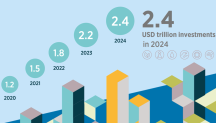

Renewables Are the Solution to Malaysia’s Sustainable Future and Renewed Climate Ambition
Newsletter
Pursuing the energy transition pathway will save Malaysia up to USD 13 billion annually, reduce its emissions significantly, and diversify its energy supply
Kuala Lumpur, Malaysia, 09 March 2023 – New report confirms Malaysia’s ability to meet its net zero goal with increased use of local and affordable renewables. According to the report’s findings, transitioning to renewable energy will save Malaysia between USD 9 billion and USD 13 billion annually by 2050 in avoided energy, climate, and health costs.
Developed by the International Renewable Energy Agency (IRENA) in collaboration with the Ministry of Natural Resources, Environment and Climate Change (NRECC), Malaysia, the report shows that by aligning its low-emission development strategies with IRENA’s 1.5°C Scenario, the Southeast Asian country can increase its share of renewables to over half its final energy mix by 2050, up from just 5% today.
With its renewed pledge to be carbon neutral by 2050 and expected increase in energy demand due to almost a tripling size of its economy in the same period, Malaysia needs to decide between continuing with fossil fuels or tapping into its significant potential of renewable energy sources. Launched in an official ceremony organised by NRECC in Kuala Lumpur today, the Malaysia Energy Transition Outlook offers a long-term energy pathway to a cleaner and more sustainable energy system.
To allow higher integration of renewables in a cost-effective manner, Malaysia needs to improve its system flexibility. Ambitious and long-term planning must emphasise solutions to overcome the current challenges of grid integration and to create grids flexibility. That is why Malaysia’s energy transition pathway sees the power sector and grid-related investments accounting to over 70% of the total investment requirement, which is at least USD 375 billion.
However, renewable energy investment remains a major hurdle to accelerating Malaysia’s energy transition. The report finds there is a need to strengthen the capacity of national financing institutions, overcome the regulatory and market barriers, as well as to reduce government spending on fossil-fuel related subsidies.
“The urgent action that Malaysia needs to take is create a more conducive investment environment for renewables. Through strategy and policies that prioritise clean energy investments and are consistent at all government levels, Malaysia can achieve its renewed ambition of reaching net zero by 2050, while securing a more prosperous, sustainable future for its people,” says IRENA Director-General, Francesco La Camera.
Highlighting the importance of the Outlook, the Minister of NRECC, YB Tuan Nik Nazmi Nik Ahmad, says, “Malaysia has a robust RE industry value chain that extends from the production to the service supply stage. What is needed is for us to leverage our competitive advantage to draw in high value yet environmentally friendly investment. This strategic intent must also be backed up by comprehensive, competitive and aspirational power generation and supply planning policies. These policies, in turn, must be sustainable energy-centric, taking into account recent trends and current socio-economic needs.”
Based on the report, electrification and energy efficiency are key measures in Malaysia’s net-zero pathway. The share of electricity in the total final energy consumption of all end-use sectors should increase from 26% in 2018 to 40% in 2050. Such an increase reflects the additional electricity demand required to electrify end-uses in industry and the transport sectors. Electric vehicle (EV) numbers must grow rapidly, with annual EV sales of more than 0.4 million annually from 2030, reaching up to 80% share by 2050.
These sectors could also benefit from enabling technologies like green hydrogen. Hydrogen demand in Malaysia is expected to grow significantly, up to 1.5 million tonnes of clean hydrogen by 2050. Furthermore, the country can position itself as a reliable partner and supplier of green hydrogen, provided that national targets, needs and mandates are met first.
The findings show solar photovoltaic as a key technology that will lead Malaysia’s energy transition regardless of the scenario, with up to 150 gigawatts of installed capacity required up to 2050. Additionally, the country needs to tap into its diverse mix of bioenergy potential. Scaling up sustainable bioenergy use can assist the transformation of the transport, industry and non-energy sectors, as bioenergy contributes around 16% to Malaysia’s total final energy consumption up to 2050.
The report also touches upon the country’s role in the energy transition of Southeast Asia. With diverse renewable power systems, Malaysia has an opportunity to provide supply and flexibility to neighbouring countries, through the deployment of energy storage and expansion of regional interconnection. Achieving the energy transition in the most cost-effective way will necessitate higher renewables integration within Malaysia’s national power systems and regionally with its neighbours.
Read the full Malaysia Energy Transition Outlook here.




